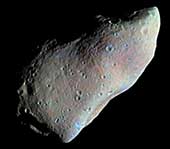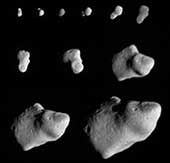
Asteroid 951
Gaspra (Asteroid 951) was discovered by Grigoriy N. Neujamin in 1916. Neujamin named Gaspra after a Black Sea retreat that was visited by contemporaries such as Tolstoy and Gorky. Gaspra was just another small asteroid that was given very little attention until it was discovered that the trajectory of the Galileo spacecraft would take it close to Gaspra. Following this discovery, observers through out the world made Gaspra a prime target of study. Gaspra was found to have an elongated shape with a rotational period of 7.04 hours.
On October 29, 1991, Galileo came within 1,600 kilometers (1,000 miles) of Gaspra. They passed each other at 8 kilometers (5 miles) per second. This was the first time that a spacecraft made a fly-by of an asteroid. Gaspra is an irregular body with dimensions of about 20 x 12 x 11 km (12.5 x 7.5 x 7 miles). Its surface reflects approximately 20 percent of the sunlight striking it. Gaspra is classified as an S-type asteroid and is likely composed of metal-rich silicates and perhaps blocks of pure metal. It is a member of the Flora family.
Several craters are visible on Gaspra, but none approach the scale of the asteroid's radius. The fact that Gaspra is irregular in shape and lacks any large craters suggests that it has a comparatively recent origin, most likely from the collisional breakup of a larger body. Gaspra has probably been in its present state for the last 300 to 500 million years.
- VRML model of Gaspra - WRL. (Courtesy A. Tayfun Oner)
- Gaspra in rotation. (Courtesy A. Tayfun Oner)
- Shape Model Animation of Gaspra. (Courtesy A. Tayfun Oner)
 Gaspra in Color
Gaspra in Color
This picture Gaspra is a combination of the highest-resolution images
and color information obtained by the Galileo spacecraft. The Sun is
shining from the right. The subtle color variations on Gaspra's surface
have been exaggerated. Albedo and color
variations are associated with surface topography. The bluish areas are
regions of slightly higher albedo and tend to be associated with some of
the crisper craters and with ridges. The slightly reddish areas,
apparently concentrated in low areas, represent regions of somewhat
lower albedo. In general, such patterns can be explained in terms
of greater exposure of fresher rock in the brighter bluish areas and
the accumulation of some regolith
materials in the darker reddish areas. (Courtesy USGS/NASA/JPL)
 Gaspra -- True & Enhanced Color
Gaspra -- True & Enhanced Color
These two color views of the asteroid Gaspra were
produced by combining three images taken through violet, green, and
infrared filters by the Galileo spacecraft on October 29, 1991, from a
distance of about 16,000 kilometers (10,000 miles). The view on the left
shows Gaspra in approximately true color; the surface is covered with
rocks that are somewhat less grey than those on Earth's moon. In the
version on the right, the colors were enhanced to bring out the muted
color variations on the asteroid and to increase the ability to
discriminate between surface features. The subtle variations in color may
be due to slight differences in rock composition or to differences in the
texture of the surface layer.
The illuminated portion seen in these views is about 16 by 12 kilometers.
 Eleven Views of Gaspra
Eleven Views of Gaspra
This set of 11 images shows Gaspra growing progressively larger in the
field of view of Galileo's camera as the spacecraft approached the
asteroid. Sunlight is coming from the right. The earliest view (upper
left) was taken 5 hours, 45 minutes before closest approach when the
spacecraft was 164,000 kilometers (102,000 miles) from Gaspra. The last
image (lower right) was taken 30 minutes before closest approach at a
range of 16,000 kilometers (10,000 miles).
Gaspra spins once in roughly 7 hours, so these images capture almost one
full rotation of the asteroid. Gaspra spins counterclockwise; its north
pole is to the upper left, and the "nose" which points upward in the
first image, is seen rotating back into shadow, emerging at lower left,
and rotating to upper right. (Courtesy NASA/JPL)
 Gaspra Compared to Deimos and Phobos
Gaspra Compared to Deimos and Phobos
This picture shows Gaspra (top) compared with
Deimos (lower left) and
Phobos (lower right), the moons of
Mars.
The three bodies are shown at the same scale and nearly the same
lighting conditions. All have irregular shapes, due to past
catastrophic events; however, their surfaces appear
remarkably dissimilar, possibly because of differences in
composition but most likely because of very different impact
histories. (Courtesy NASA/JPL)
 Simple Cylindrical Map of Gaspra
Simple Cylindrical Map of Gaspra
This image is a Simple Cylindrical map of Gaspra centered at 0 degrees
longitude. It was constructed from Galileo images of Gaspra and shape
model of Peter Thomas.
(Courtesy A. Tayfun Oner)
 Topographic Map of Gaspra
Topographic Map of Gaspra
This is a topographic map of Gaspra. It is based upon the shape model of
Peter Thomas and his colleagues. It was adapted and modified by Phil
Stooke.
(Courtesy A. Tayfun Oner)

 Asteroids
Asteroids Ida
Ida